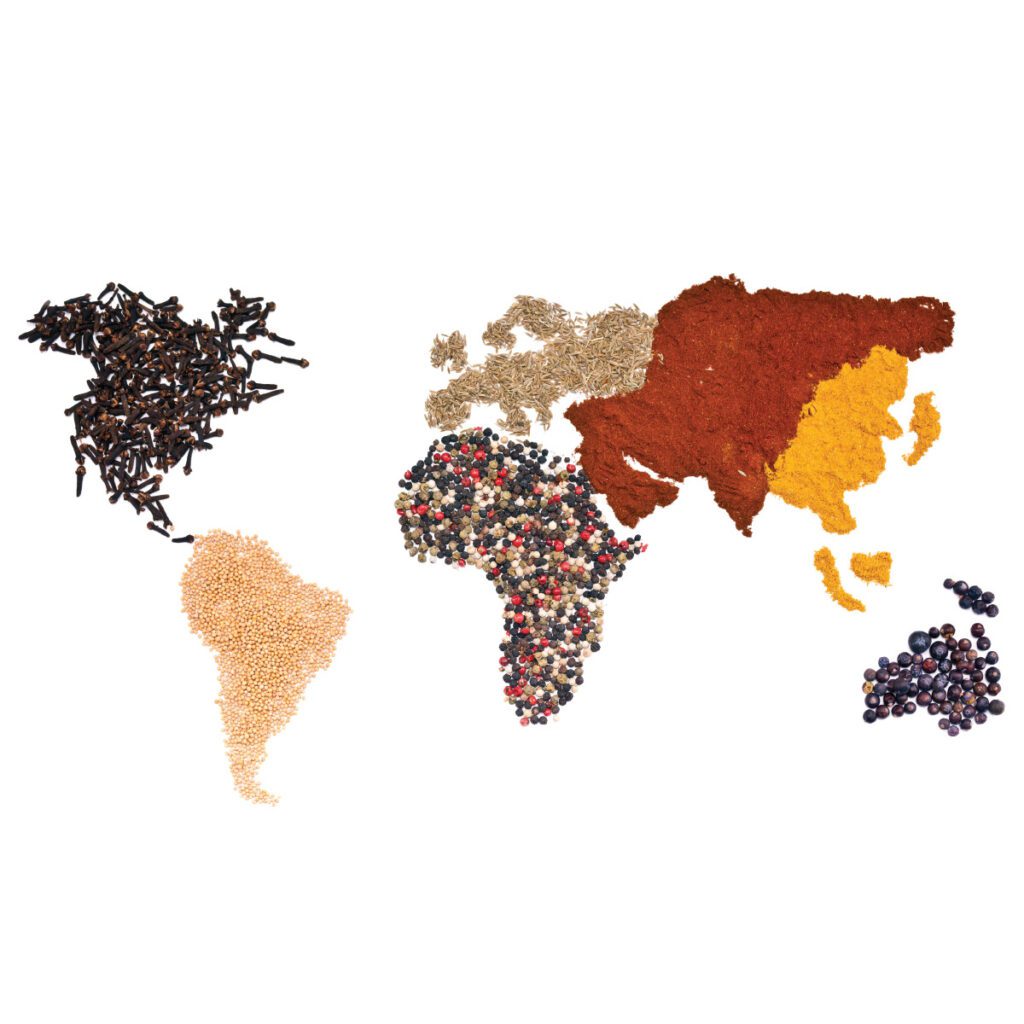To Get Healthy, Go Global!
When it comes to healthy eating, Americans don’t always have the best reputation. How do we reverse the trend in 2017? One answer lies in diets indigenous to different parts of the world.
Japanese
The Japanese have an ancient teaching that goes: “hara hachi bu,” which means “eat until you are 8/10ths full.” By focusing on smaller portions and taking a mindful approach to satiation, this culture makes health a priority – and it’s paying off. The country’s obesity rate is under 4%, and Japanese women have a higher life expectancy than women anywhere else in the world.
“Hara hachi bu is a completely different mindset than we have here in the U.S.,” says Kari Intemann, registered dietitian at Hamilton Diabetes and Nutrition Center and Hamilton Weight Management. “It’s a big reason why the Japanese live so much longer, and it’s similar to the philosophy we teach in our weight loss classes.”


The Japanese also limit intake of red meat, which contains saturated fats that can lead to clogged arteries. Instead, they eat a half pound of fish per day on average, with two fish courses often presented in a single meal – one hot and one cold. Other proteins are plant-based, like tofu, which is high in calcium and low in saturated fat.
This culture eats with their eyes too. Plate prep is an art form, and this focus on display puts the brakes on any rush to start a meal.
“They serve entrees in decorative dishes and pay close attention to colors and textures,” says Angie Hamilton, registered dietitian at Parkridge Medical Center. “This is very different from the American tendency to use one giant platter and fill it full.”
Even the bento boxes sent to school with children include treasures. Rice is rolled in seaweed, prawns are decorated with accents, and carrots are cut into animal or anime shapes.
Mediterranean
Why count calories when you can focus on lowering fat intake instead? That’s one of the sentiments that makes Mediterranean eating so health-conscious. Natives of Greece, Spain, Morocco, and other countries bordering the Mediterranean Sea pass on added fats when cooking (think: butter and margarine). Instead they flavor their dishes liberally with herbs, spices, olive oil, and citrus juice.
These cultures also pass on added salt. Who needs sodium when you can experiment with bay leaves, rosemary, cilantro, coriander, and lemon juice? “Here in America, we probably eat twice as much salt as we need,” says Sharon Hopper, registered dietitian at CHI Memorial Center for Cancer Support. “The great thing about spices and herbs is that they not only improve flavor, but offer important inflammatory properties that boost our immune systems.”
If you want to try a Mediterranean-inspired diet, start with a few basic principles. Experiment with seasonings, shift your focus to vegetables and fish, and find what’s seasonal. The good news is, you don’t have to cut out bread. Just opt for non-processed grains like barley, millet, oats, couscous, polenta, and rye.
Finally, supplement your diet with moderate amounts of cheese and yogurt, nuts and seeds, and legumes like beans, lentils, and chickpeas. Drink lots of water, but indulge in a little wine as well – up to five ounces per day for women and 10 ounces per day for men.
New Nordic
In 2003, two Danish chefs opened a restaurant that would become one of the world’s most acclaimed eateries. Called Noma, it became famous for its use of locally sourced, seasonal ingredients. Noma’s philosophy was so successful that it would become viewed as the head of a new movement to spread New Nordic cuisine.
Today, the New Nordic diet is considered the newest player in the healthy eating game. It’s much like the Mediterranean diet in its focus on seafood, vegetables, and whole grains. A key difference is its commitment to non-processed, locally grown foods.
Recipes from Denmark, Finland, Iceland, Norway, and Sweden are rich in berries, pears, cabbage, carrots, beans, mushrooms, fennel, peas, and dark, leafy greens like kale. Instead of olive oil, the Nordic diet relies on rapeseed oil, which contains healthy fats and a plant-based omega-3 fatty acid. Free-range herring and salmon are popular proteins, as is wild game like elk.
So how would an American adapt to New Nordic eating habits? Stay away from processed foods and fatty red meats, and prepare simple meals using local ingredients. If elk and venison aren’t high on your favorites list, opt for grass-fed or organic meats. If you can’t find rapeseed oil, incorporate canola oil instead – it’s almost identical and high in healthy monounsaturated fat. Finally, check out the local farmer’s market or buy a “share” of seasonal produce from a regional farmer. The New Nordic Diet itself may not be a realistic option, but it can inspire you to place quality ingredients at center stage.
French
When it comes to French-style cuisine, it’s more about how you eat than what you eat. First, take your time. Dining is viewed as a ritual, a celebrated tradition. You need company and conversation. Traditional French dining includes courses at both lunch and dinner. By spending more time at the table, you can focus on conversation – much of it centered on the food itself.
Timing is also key. Lunch is the largest meal of the day, with lighter fare like soups and omelets enjoyed in the evenings. Meanwhile, snacking is almost unheard of. “In America, we eat everywhere – in the car, at our desks…we’re constantly picking up a handful of this, a handful of that,” says Hopper. “But in France, they pay attention to food, and they don’t usually graze between meals.”
Grocery shopping is almost more important than mealtime itself. The French visit the local market several times throughout the week and are willing to spend on quality ingredients. Unlike us, who expect to enjoy certain foods all year, they reserve their pantries for seasonal produce. It may mean giving up strawberries or tomatoes come winter, but to the French, freshness and taste are worth it.
Finally, the French truly disdain processed foods. Why eat a large slice of low-fat pie when a small piece of dark chocolate will suffice? “They aren’t familiar with the kind of food ‘guilt’ we have in America,” says Intemann. “They eat real foods and full-fat foods – they simply eat smaller portions and take time to savor them.”
West African
Africa’s arid climate lends itself to sturdy crops like sorghum, millet, and barley as well as root vegetables like yams and cassavas. Regular consumption of these unprocessed starches can prevent constipation and improve blood cholesterol and glucose levels.
In West Africa, beef, goat, and sheep are considered by most to be expensive, so these proteins are reserved for special occasions. Plus, these meats tend to be leaner than those found in the U.S, since animals on the Savannah roam free. Fish, however, is abundant near the coast, and is often added to stews served over a root vegetable mash. The base for the stew varies depending on the region: palm oil, ground nut paste, okra, or eggplant.
Natives of West Africa focus on natural flavors by cooking without added fats. Ingredients are boiled, roasted on a fire, or wrapped in leaves and steamed. To mimic these health benefits, try a simple mashed potato-style dish called fufu. Place white or yellow yams in a pot of cold water, then boil until soft. Peel the yams, add butter, then mash and stir with a wooden spoon until smooth. Form the fufu into small balls, and enjoy with stew or gravy.
Takeaways
Where to from here? One takeaway is that, while most of these diets do not exclude meat entirely, meat is treated like a side dish. Meanwhile, vegetables, leafy greens, whole grains, and legumes take center stage. “Generally, these diets tend to be more plant-based, with limited processed foods and snacking,” says Hopper.
Another big takeaway is an appreciation for great food. “Our culture is on the go. We don’t take time to savor quality,” says Intemann. “A value for real foods is a common element among these cultures – and it’s one we tend to lack.”
Hamilton agrees. “We are so developed compared to other countries, that we’ve actually overdeveloped our food culture,” she says. “We’ve done ourselves a disservice by not eating anything fresh or whole. Americans often confuse enjoyment of food with overconsumption. For us its more about quantity, whereas for many other cultures it’s about quality. We are all you can eat, and many of these cultures are all you need to eat.”



Kari Intemann, RD, LDN
Diabetes Educator, Hamilton Diabetes and Nutrition Center and Hamilton Weight Management



Angie Hamilton, RD, LDN
Parkridge Medical Center



Sharon Hopper, RD, LDN
Clinical/Oncology Dietitian, CHI Memorial Center for Cancer Support

